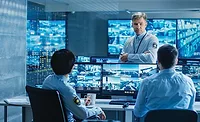Using IP Video to Reclaim Critical Resources in Battle Against COVID-19

As the COVID-19 virus continues to spread throughout the world, hospitals are struggling to provide patient care, ensure the health and safety of medical personnel, and protect vital supplies from theft. As IP technology continues to improve the functionality and performance of video surveillance, more hospitals are using video monitoring for digital care solutions. From thermal scanning cameras, to video analytics driven by machine learning to remote monitoring Internet of Things (IoT) sensors, hospitals are using technology to fill the care gap and safely expand the monitoring of patients with coronavirus.
Now more than ever, open platform video management system (VMS) technology can take on a bigger role beyond traditional security at hospitals. This real-time data and observation can improve the safety of the patient environment and the quality of care, not only for patients but also for hard-working medical personnel.
Video Monitoring
Many hospitals currently use network cameras for surveillance, security and situational awareness throughout the interior and exterior of facilities. In addition, different types of IP video devices can assist hospital staff in safely monitoring contagious patients, including thermal, infrared and high-definition cameras, plus many other types of lenses. An open platform VMS gives hospitals the ability to quickly and securely integrate these new capabilities and services.
Prior to the coronavirus outbreak, Nemours Children’s Hospital in Orlando, Fla., recently deployed fixed network cameras in every patient room to provide an additional level of patient monitoring beyond nurses and clinical staff. Cameras are equipped with a privacy LED light indicator, letting patients know when the camera is in use. When an alarm trigger is activated, highly trained paramedics from the hospital command center monitor the patient via a live feed. These paramedics can also assist patients via audio and alert other rapid response teams if needed.
Now this video monitoring technology is changing the way Nemours performs patient rounding, according to Healthcare IT News. Before the outbreak, daily patient rounds would occur in the hallway, allowing a team of up to 14 allied healthcare professionals and parents to discuss the patient’s condition and coordinate a plan of care.
Nemours quickly revamped patient rounding so that a maximum of three people comprises the hallway team, while other members of the care team connect remotely to the VMS using their own devices to participate. Nemours has conducted about 340 virtual rounding visits per week since it went live with the new system at the end of March. It has helped in saving personal protective equipment (PPE) and reducing direct contact with patients.
Machine Learning Video Analytics
Video analytics software can analyze every single frame of video and flag potential issues as they occur, which allows hospital staff to make better, more informed decisions. Machine learning uses algorithms to discover patterns and generate insights from video data. Deep learning, a more advanced subfield of machine learning, uses repetitive example-based training to teach video analytics software how to identify patterns, classify information and predict behavior from video surveillance.
Video technology also has the potential to notify nurses if a patient’s dressings have not been changed or if a bed-bound patient needs assistance. Video analytics can alert hospital staff if a patient falls by distinguishing between the movement of a person lying down on a bed or sitting on the floor.
As well as helping medical staff improve patient care, video analytics can also increase efficiency. By analyzing patient behavior patterns at different hospital locations and times of the day, analytics can improve staffing levels by providing accurate information about where staff members are being posted, versus where the highest amount of activity is occurring. This can help hospital administrators make the best use of resources and help improve emergency procedures.
Remote Monitoring IoT
Physicians can remotely monitor patients when patient data is linked to the hospital VMS. For example, in the Nemours’ cardiac unit, physiological monitor information is displayed on the VMS, allowing cardiac intensivists to monitor patients around the clock. Using remote connectivity to the VMS, cardiologists can quickly check in on patients through their smartphones or mobile devices.
Healthcare providers are also finding ways to use medical-grade sensors to gather data and provide quality telemedicine to patients at home. For instance, a hospital in Boston has adapted its telehealth video system to provide remote monitoring of coronavirus patients recuperating at home, according to NBC News. Patients wear IoT sensor devices that allow doctors to monitor their oxygen level and heart rate remotely. This could help in freeing up hospital beds and saving PPE supplies.
In Hong Kong, researchers and clinicians are using remote monitoring technology to better understand the coronavirus, according to the Wall Street Journal. Using medical-grade sensor devices worn by patients quarantined in their homes or hospitals, researchers can monitor and analyze real-time data, such as body temperature, respiratory rate, blood oxygen level and heart rate. Clinicians can then apply personalized, predictive analytics to provide more effective interventions.
As hospitals are stretched thin by this health crisis, open platform technology can continue to play a crucial role in integrations with systems for staff shift monitoring, building control and management, traffic management and complying with regulations for hygiene, fire and environmental issues. More importantly, video surveillance technology can provide new solutions for protecting and monitoring patients who need it most.
Looking for a reprint of this article?
From high-res PDFs to custom plaques, order your copy today!









